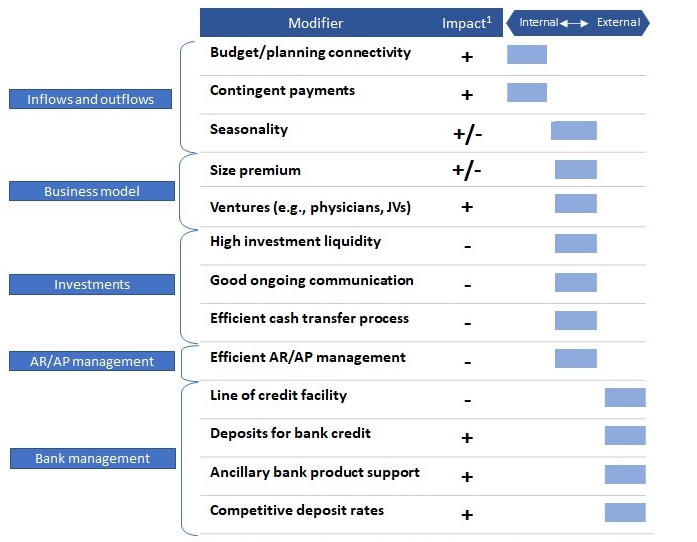Liquidity levels in a COVID world: Why healthcare finance leaders should be paying attention

Establishing a right-sized liquidity target is a first step in building a resilient organization.
By delivering a direct hit on the healthcare operations of U.S. hospitals and health systems, the coronavirus pandemic has presented these organizations’ leaders with a worst-case scenario that almost certainly surpasses anything they have encountered over the past 20 years. Yet in the midst of this crisis, many also are finding they have excess liquidity levels on hand as a result of a variety of factors, including federal grant funding and advance payment mechanisms, forgone capital spending plans, numerous credit facilities and even asset reallocation decisions.

This situation underscores the need for healthcare finance leaders to focus on building resilience into their organizations by making sure that every resource is tightly managed and optimally deployed.
Securing surplus liquidity was the focus of the early days of the pandemic, and maintaining sufficient liquidity remains a critical component in an organization’s strategic allocation of resources. But liquidity resources take several forms, including operating cash, bank facility resources (i.e., lines of credit), invested assets and other leverage tools.
Carrying an excess amount of one liquidity resource when other resources are available can come with significant economic opportunity cost. The question now becomes whether, and to what degree, providers unwind their excess liquidity positions in favor of a more streamlined cash management process.
A focus on operating cash
After the experiences of 2020, finance leaders may be understandably biased in favor of carrying significant operating cash balances. With the need to redeploy resources efficiently, however, finance leaders should consider how to size operating cash balances appropriately. An approach that combines analysis of historic cash flow data with consideration of disruptive modifiers enables finance leaders to determine the right-sized operating cash target for their organization.
Such an analysis provides a customized baseline and is therefore more effective than performing an ad hoc peer analysis or establishing a static days-cash-on-hand threshold based on quarterly or annual data.
The process of arriving at a right-sized operating cash target involves three key considerations:
- What is the ideal sizing target for meeting routine cash demands alone?
- Beyond routine cash demands, what other modifiers, both external and internal, should be considered?
- Should the organization leverage short-term credit to support operating cash?
Meeting cash demands. The most conservative position for operating cash is being able to cover a worst-case scenario: A time period (e.g., 20 days) when there are no cash inflows but regular cash outflows. Even at the height of the pandemic, few organizations were in a position in which there were no cash inflows, which suggests most organizations can be more aggressive in setting their operating cash target. An analysis of historic data on operating cash inflows and outflows, for example, allows finance leaders to understand patterns in operating cash demand and to establish a target based on regular maximum cash outflows over a defined time period.
Not-for-profit health systems can look to their for-profit counterparts to see the potential for operating cash efficiency. Because cash reserves dilute ROI, for-profit systems have an incentive to limit the amount of operating cash they accumulate.
Other risk analytics may come into play for not-for-profit health systems, but comparisons with for-profit systems also can expose material operating cash inefficiencies. Also, rating agency analytics will show that the amount of cash health systems carry on their balance sheet varies significantly, but there is little correlation with revenues or ratings.
Accounting for modifiers. A variety of potential modifiers, both internal and external, may justify increasing or decreasing the operating cash target (see exhibit below). Certain geographic markets, for example, see significant seasonal variation in volumes, with corresponding seasonal fluctuations in operating cash inflows. A health system may be planning a strategic initiative that will require significant upfront investment before anticipated returns are realized.
Illustrative operating cash target modifiers

*Impact refers to influence on increasing (+) or decreasing (-) cash balance target. For illustration only.
Source: Kaufman, Hall & Associates LLC
The examples shown in the exhibit are not all-inclusive. The list of potential modifiers will reflect specifics of an organization’s evolving business model and the market or markets in which it operates. A single-site hospital, for example, may require a larger pool of operating cash than a diversified regional health system with multiple facilities or joint ventures in multiple markets.
Similarly, political factors may need to be considered in states that withhold or delay Medicaid payments to alleviate budgetary pressures. A careful assessment of the potential impact of market-specific modifiers can help ensure proper risk-adjustment of the operating cash target.
Leveraging short-term credit. The bank credit markets moved quickly against borrowers in March 2020 as credit availability was reduced and pricing and terms changed quickly. The rush to secure short-term credit facilities provided meaningful additional liquidity to hospitals and health systems in the early days of the pandemic. As finance leaders work to right-size their operating cash target, they also should consider whether short-term credit facilities can effectively provide both a backstop for managing operational headwinds and volatility that may lie ahead and a tool for routine capital management. A new or enhanced line of credit may be particularly useful as a hedge against any risks above baseline operating cash demands identified in the organization’s assessment of external and internal modifiers.
4 key goals to proactively manage operating cash
By proactively managing operating cash, finance leaders can accomplish four key goals.
1. Manage liquidity resources. Sizing liquidity is both art and science, requiring strong analytics and subjective inputs that consider an organization’s financial position, operations and strategy. Flexibility is required, given variances in organization size, ratings and position in the business cycle.
2. Maximize value in the market. An efficient operating cash target frees up resources that can be invested for greater returns. Several short-term investments can yield significantly more than excess operating cash deposits with conservative risk and liquidity profiles. Longer-
term investments can produce even higher yields, although they carry additional risks and considerations.
3. Promote efficiency as a mission. A duty of the treasury function is to apply available resources to advancing operations and strategy, as opposed to building an excess buffer. Proactive operating cash management helps to fulfill this duty.
4. Achieve cash visibility. A well-run treasury function requires the tools to forecast cash effectively and manage working capital levels efficiently. Top-performing treasury teams typically use technology solutions available in the market to manage this process by automating data input and delivering robust reporting.
Next steps to building a resilient organization
Establishing a liquidity target is a first step in the process of building a resilient organization, not an endpoint. Finance leaders should put a framework in place that allows them to regularly monitor inflows and outflows of operating cash and establish a schedule of check-ins — on an annual basis at minimum — to revisit and evaluate the efficiency of the operating cash target as the organization and its market evolve.
Success in promoting operating cash efficiency also may encourage a broader assessment of how organizational resources are managed and deployed. Although finance leaders cannot predict everything that lies ahead, a constant focus on strategic resource allocation will help build the resiliency needed to withstand inevitable future shocks and keep their organizations on course and on mission.





